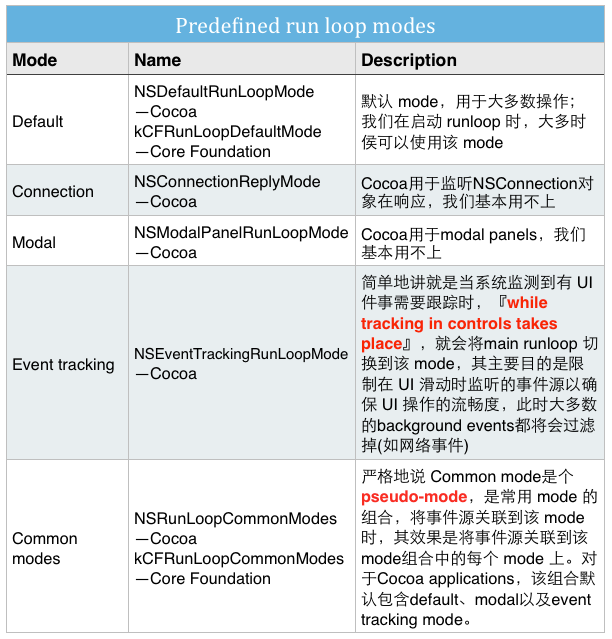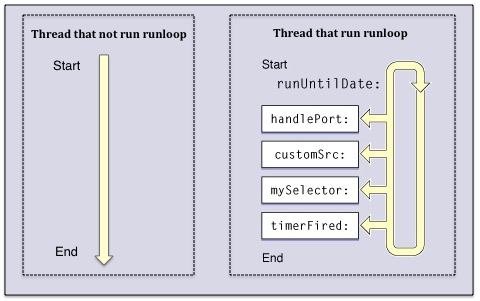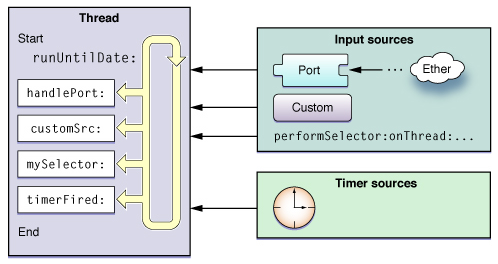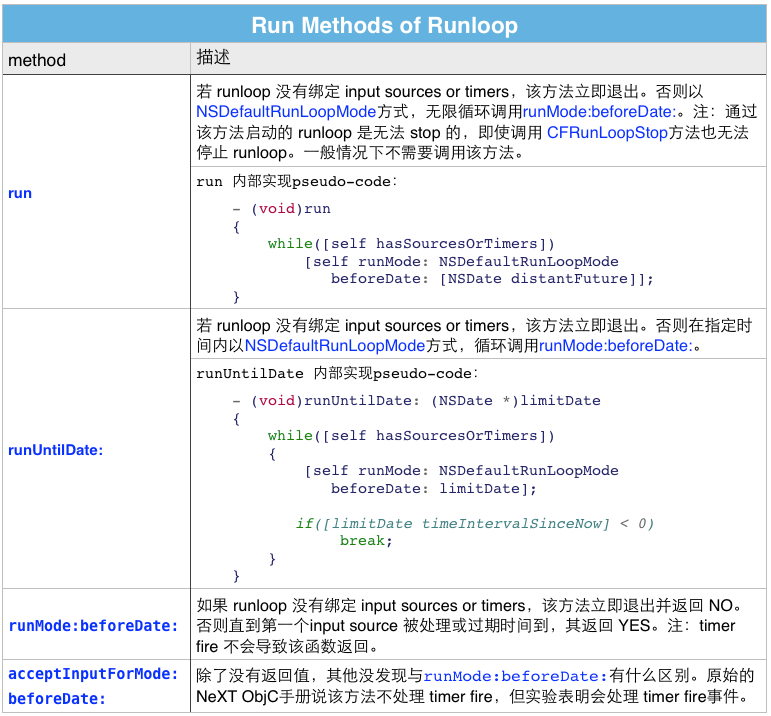希望通过本文的介绍,大家能更清晰地认识 runloop。本文是 runloop 系列的第一篇文章,主要介绍 runloop 的基本概念及其与线程的关系,并试图通过pseudo-code的方式探索 runloop 的内部实现机制。
©原创文章,转载请注明出处!
Overview
刚开始接触 iOS 时,block 和 runloop 让我望而生畏。block 那神奇的语法以及与外部变量纠缠不清的关系,还有 retain cycle 这个恶魔,短时间确实难以接受!runloop 更是谜一样的虚无飘渺,又似乎若隐若现,仿佛能感受到它的存在,但始终又不得其真面目!
Apple 官方给 run loop 的定义:run loop 是线程的基础支撑,是循环处理事件的机制,一个具体的 run loop 就是一个事件处理循环。
run loop 的目的是使线程在没有事情可做时进入休眠状态,避免 CPU 空转。
Run loops are part of the fundamental infrastructure associated with threads. A run loop is an event processing loop that you use to schedule work and coordinate the receipt of incoming events. The purpose of a run loop is to keep your thread busy when there is work to do and put your thread to sleep when there is none.
Runloop Modes
简单地说,runloop mode 是事件源的集合 + runloop观察者的集合。runloop 每次都运行在某个特定的 mode 上。
之所以要引入 mode 的概念,是希望 runloop 在监听过程中过滤掉不关心的事件源,只专注于某些特定的事件。
Cocoa and Core Foundation已经为我们预定义了若干 mode,而我们也可以自定义 mode。

如果某个 input source 所属的 mode 不是当前监听的 mode,那其产生的所有事件都将被 hold 住,直到 runloop 运行在与其匹配的 mode 上。
注意:当有 UI 滑动事件时,系统会将main runloop切换到NSEventTrackingRunLoopMode,以限定此时的事件源,确保滑动的流畅性。
同时,在默认情况下NSRunLoopCommonModes包含NSEventTrackingRunLoopMode,也就是说与NSRunLoopCommonModes关联的事件源也与NSEventTrackingRunLoopMode关联。
而此时,如果有子线程想通过performSelecorOnMainThread...或dispatch_async(dispatch_get_main_queue(),^{})在主线程上执行某 selector,默认情况下上述两种方式产生的事件是关联到NSRunLoopCommonModes,因此在 UI 滑动时也会响应该事件并执行指定的 selector,从而影响滑动的流畅性。
为了避免此问题,可以封装上述接口,使其指定的 selector 运行在 main runloop 的其他 mode 上,如:NSDefaultRunLoopMode。
Runloop and Thread
如果要问runloop 与 thread 是什么关系?
答:runloop 是 thread 不断跳动的心脏!
每个 thread 都有自己的 runloop,可以通过NSRunLoop的类方法currentRunLoop获取当前线程的 runloop。但只有 main thread 的 runloop 默认是开启的,其他线程如果希望持续存活下去,就需要手动开启runloop。
当线程没有开启 runloop 时,其生命周期将随其 main 函数的结束而终结;当开启 runloop 时,线程会进入休眠状态,直到相应的事件到来。形象地说前者生命周期是条直线,后者是个圆。
那么什么情况下需要开启线程的 runloop 呢?(当然,这里讨论的对象是子线程)
基本原则是:线程需要处理异步事件。
如果线程只是用来处理同步任务,没必要开启 runloop,也就是说 runloop 一定是与异步事件相关的!
具体来讲大概以下几种情况需要开启 runloop:
- 需要通过端口或自定义输入源与其他线程通讯;
- 在线程中需要使用定时器;
- 在线程上使用
performSelector系列方法; - 需要线程周期性地执行一些任务。
至于如何开启子线程的 runloop 就不过多的讲了,可以参考一下 Apple 的官方文档:Threading Programming Guide
需要注意的是,在开启 runloop 前,至少要绑定一个事件源到 runloop 上,否则 runloop 将直接退出。
事件源大概有四类:
- Port-Based Sources
- Custom Input Sources
- Cocoa Perform Selector Sources
- Timer Sources
严格来讲,前三种事件源自来线程外部,Apple 将其称之为 input sources,timer 是来自线程内部的,与前三者有所区别。
对于上述事件源有几个要注意的点:
- 在子线程上执行 performSelector 时,子线程需要开启 runloop,不然selector将会入队,直到 runloop 启动才会被执行;
- 所有入队的 perform selector 将会在一次 runloop 中全部被处理,而不是每次 runloop 处理一个 selector;
- 当 selector 执行后,该 perform source 会被从runloop 上移除掉;
- 因 timer 触发的事件不会使 runloop 退出,(port-based input source even会使 runloop 退出);
- 当 timer 触发时 runloop 正在处理其他事件,timer handler需要等到下一个 loop 才会被执行;
- 如果 runloop 没有启动,timer 永远不会触发。
线程、runloop 以及 event source 之间的关系(来自):
NSRunLoop Internals
NSRunLoop向外提供了多个接口可以启动 runloop,详细描述如下表所示:
可以看到,run以及runUntilDate:内部都是通过调用runMode:beforeDate:函数实现的。
对于熟悉服务器网络编程的同学来说,后台服务器其实就是一个大 runloop,其主要通过 select、pool 或 epool 等方式实现这个 runloop。以select为例,系统内核不断轮询该select关注的 fd,当有网络事件需要处理时,唤醒服务器进程处理事件,否则不断轮询。
Mike Ash大神通过select,以pseudo-code的方式描述了runMode:beforeDate:的实现,同时也形象地说明了 runloop 的实质:
1 | - (BOOL)runMode:(NSString *)mode beforeDate:(NSDate *)limitDate |
在上述runMode:beforeDate:的pseudo-code中:
- 第3行,首先判断是否有 input source 或 timer 绑定到 runloop 的指定 mode 下;
- 第13行,用指定 mode 下的 inputsource 设置 fdset;
- 第23~24行,找出此次轮询的最小过期时间;
- 第27行,启动 runloop;
- 第30行,select 返回,表明有 inputsource 到达或timer fire;
- 30行以下代码用于处理到达的事件,需要注意的时:如果 select 是因为 inputsource 到达而返回的,第33行会将
didFireInputSource设为 YES,从而导致runMode:beforeDate:退出,而 timer fire 时没有设该标志位,也就是所谓的 timer fire不会导致 runloop 退出。
是的,runloop 其实就这么简单。当然,由于没有 runloop 的源码,其内部真正如何实现不得而知。但总体思路应该大同小异!